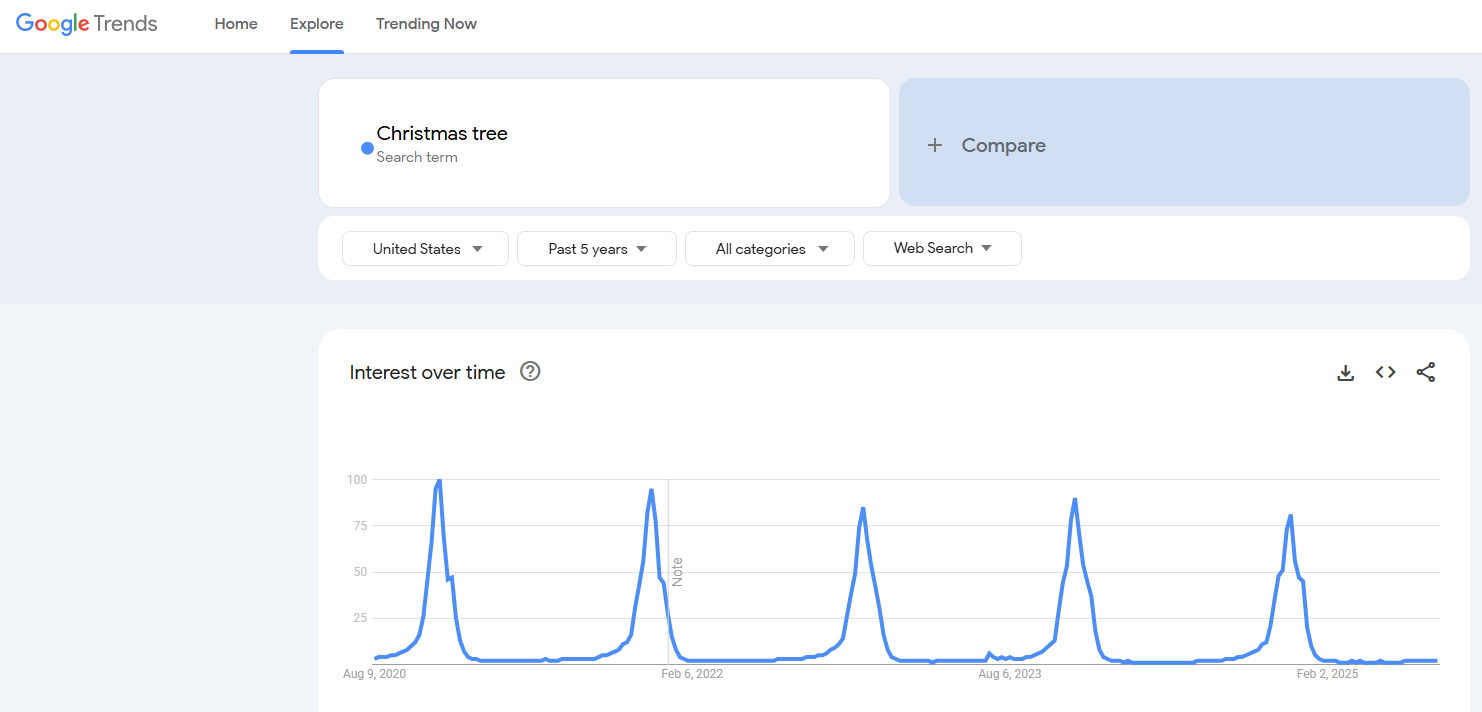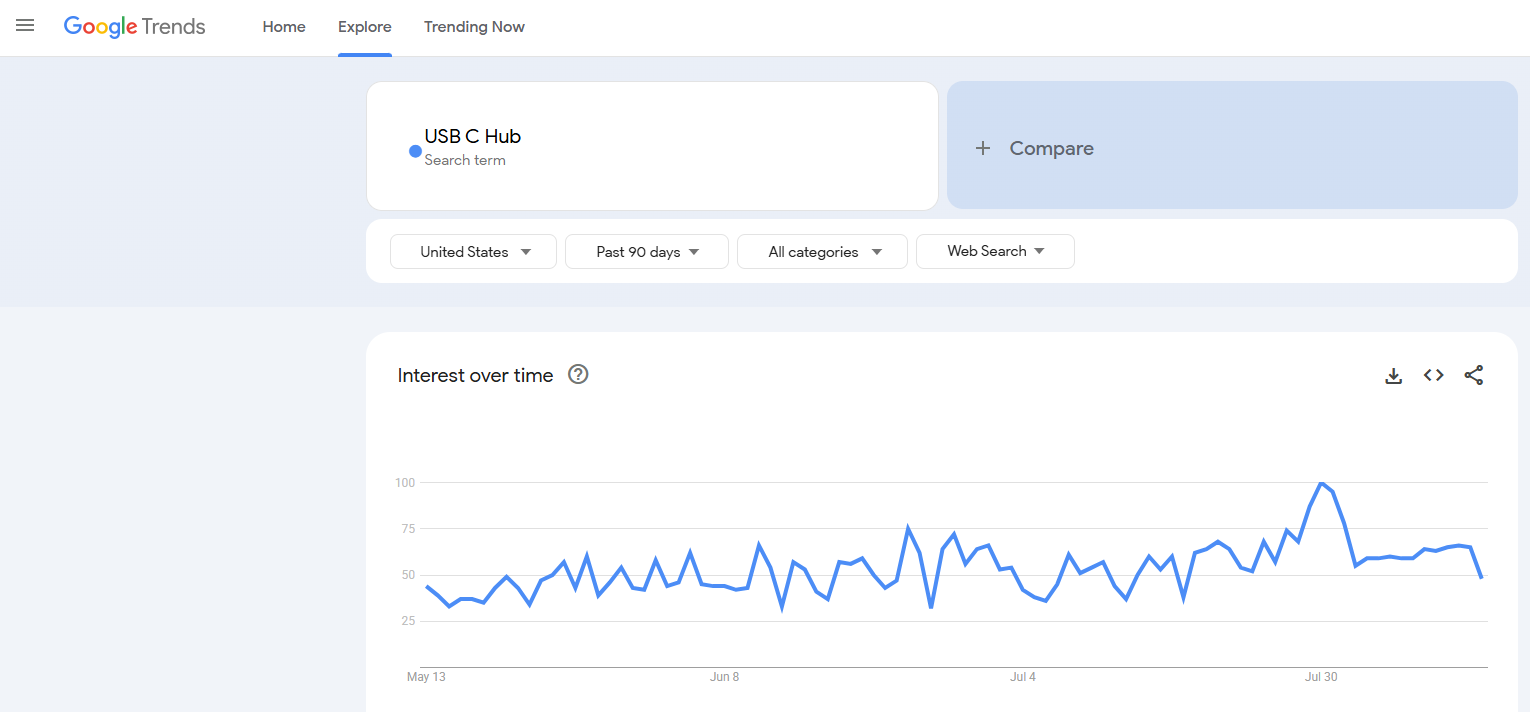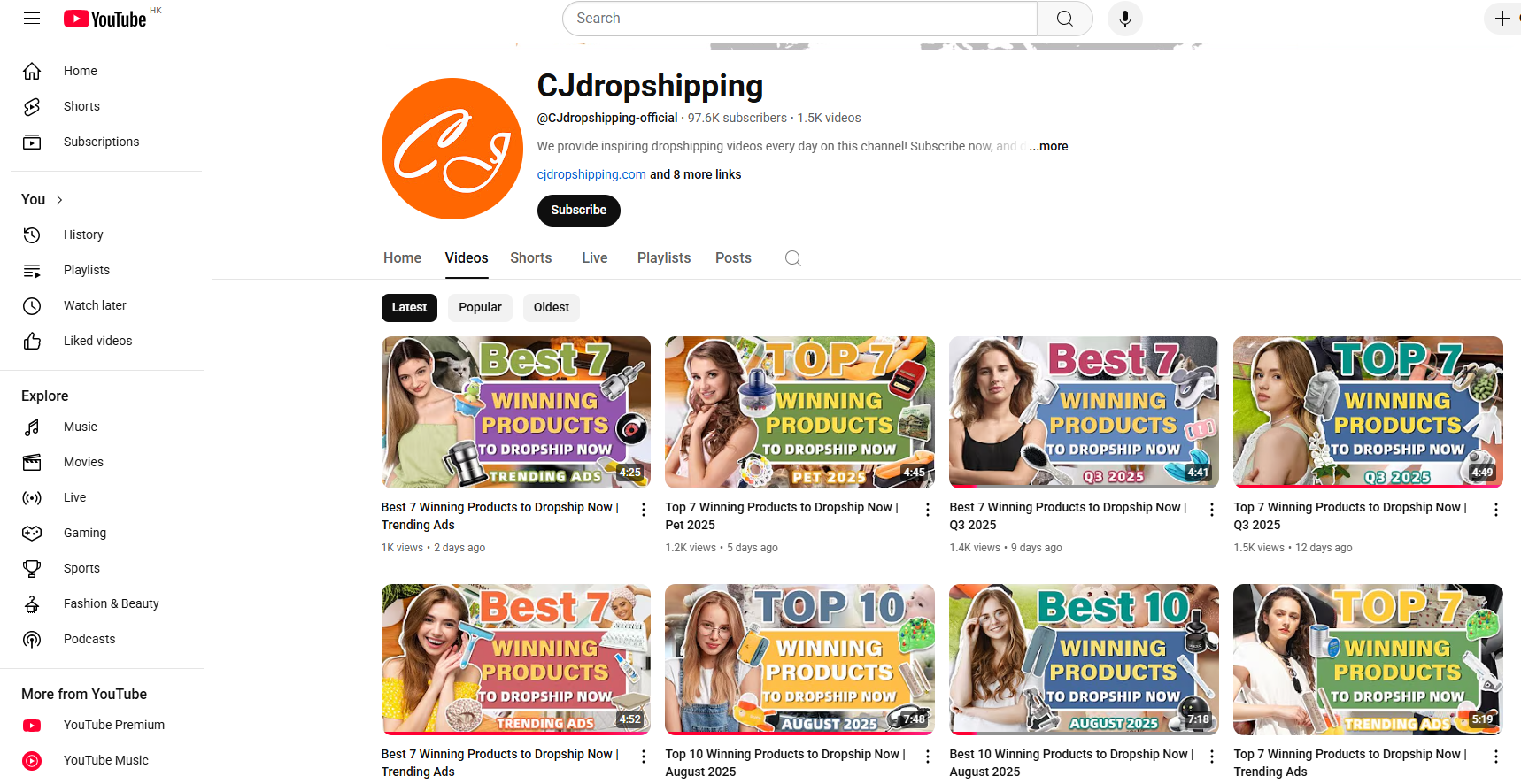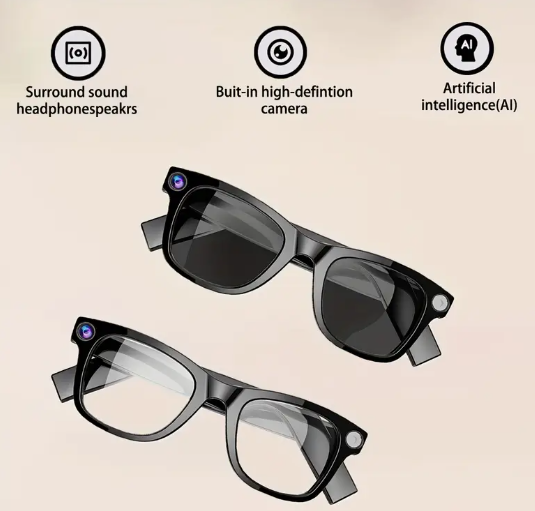Turning Google Trends Insights into Long-Term Sales
Spotting a product’s upward curve on Google Trends is only the first step. The real challenge — and opportunity — lies in turning that short-term buzz into sustainable revenue.
The key is to treat each trend not as a one-off sales spike but as a gateway to building a brand customers return to. Start by understanding why the trend exists. Is it seasonal, fueled by social media, tied to a cultural moment, or linked to a shift in consumer habits? Once you know the driver, you can plan content, marketing, and product variations that extend its life beyond the initial hype.
Diversifying your product lineup is another smart move. If one trending product sells well, look for complementary items that fit the same audience’s needs. This not only boosts average order value but also keeps your store relevant even if the original item slows down.
Strong fulfillment partnerships make a big difference here. Suppliers like CJdropshipping help you quickly source related products, handle automatic order processing, and ship from multiple global warehouses — making it easier to adapt when trends shift.
Lastly, keep refining your store’s positioning. The most successful sellers don’t just follow trends — they establish themselves as the go-to source in a niche. By combining ongoing market research with solid operations, you can turn Google Trends discoveries into products that sell steadily, season after season.
When it comes to finding the next big seller, timing is everything. Catch a product just as interest starts climbing, and you can ride the wave of growing demand while competitors are still figuring out what’s happening. Google Trends gives you exactly that kind of insight — real-time data on what people are searching for, how interest is shifting, and whether the trend is seasonal or part of a bigger market shift.
For e-commerce sellers, this is more than just a curiosity tool. It’s a way to move beyond guesswork and base product selection on hard data. Whether you’re running a Shopify store, a niche online shop, or a global dropshipping operation, Google Trends can help you decide what to stock, when to launch, and how to market it.
The real advantage lies in spotting patterns early. Many products that become viral sensations show subtle growth signs weeks or even months before they hit mainstream awareness. Sellers who use Google Trends effectively can identify these signals, secure reliable suppliers, and prepare marketing campaigns before the market gets crowded. In 2025, with consumer preferences shifting faster than ever, having a data-driven way to pick products can mean the difference between leading the market and playing catch-up.

How Google Trends Works for Product Research
Google Trends is essentially a public window into what the world is searching for, updated in near real time. By entering a keyword or topic, you can see how interest in that term has changed over time, which regions are most engaged, and what related searches are gaining traction. For product research, this means you can move beyond assumptions and see genuine search patterns from potential customers.
For example, instead of simply knowing that “air fryers” are popular, you can see exactly when their search volume spikes each year, which states or countries are showing the highest interest, and which related items — like “mini air fryer” or “air fryer liners” — are emerging alongside them. This helps you understand not just the popularity of a product, but its sales cycle, peak buying seasons, and possible upsell opportunities.
The tool also lets you compare multiple products side by side. If you’re debating between selling “LED desk lamps” or “smart light strips,” Google Trends can reveal which is trending upward faster, where the demand is strongest, and whether the growth is steady or just a short-term spike. This kind of comparative data can guide inventory decisions and marketing budgets with far greater accuracy than relying on instinct alone.
When used regularly, Google Trends becomes more than a research tool — it’s an ongoing pulse check on consumer interest. Sellers who integrate this data into their sourcing, advertising, and content strategies are far better positioned to spot winning products before they hit peak saturation.
Key Benefits of Using Google Trends for E-Commerce Sellers
For e-commerce sellers, Google Trends isn’t just a curiosity tool — it’s a direct line to understanding what customers are actively searching for right now and where the market is heading. Used strategically, it can significantly reduce guesswork in product selection and marketing.
1. Spot Trends Before They Hit the Mass Market
By monitoring search growth in its early stages, sellers can identify products that are just starting to gain attention. This early entry often means less competition, better ad performance, and higher profit margins before the niche becomes overcrowded.
2. Understand Seasonal and Regional Demand
Google Trends makes it easy to see when interest in a product peaks and in which regions demand is strongest. This helps with planning inventory for holiday surges, running location-specific ads, and deciding which fulfillment centers to stock.
3. Compare Products for Smarter Decisions
If you’re unsure whether to sell product A or product B, side-by-side trend comparisons show which has more growth potential. This ensures that marketing budgets and sourcing efforts go toward the products most likely to deliver consistent sales.
4. Discover Related Product Opportunities
Related search suggestions can reveal complementary products to bundle or upsell. For example, interest in “home office desk” might also bring opportunities for “ergonomic chair” or “desk organizer,” opening up new cross-selling strategies.
5. Back Marketing Strategies with Data
Instead of relying solely on intuition, you can use trend graphs and data as proof points in ad campaigns, investor discussions, or supplier negotiations. Data-driven insights often lead to stronger partnerships and more targeted campaigns.
When integrated into your sourcing process, Google Trends becomes more than a research tool — it becomes a competitive advantage, helping sellers choose products with both immediate sales potential and long-term viability.
How to Spot Rising Product Opportunities Before the Competition
Catching a product trend early is one of the fastest ways to build momentum in e-commerce — but it requires knowing what signs to look for before the masses catch on. With Google Trends, you can spot these signals by combining search data with a seller’s eye for market gaps.
1. Look for a Steady Upward Curve, Not Just a Spike

Sudden search spikes can be caused by temporary events or viral moments that fade quickly. Instead, focus on products with a gradual, consistent climb over several weeks or months. This suggests organic growth and stronger long-term potential.
2. Cross-Check With Related Search Terms
A single keyword might not tell the whole story. If “smart mug” is trending, check related searches like “temperature control mug” or “USB heated mug.” When multiple related terms are also on the rise, it’s a sign the niche is building a broader audience.
3. Monitor Early Adopters’ Behavior

Look at how small TikTok creators, niche YouTubers, or micro-influencers are showcasing the product. Early adoption in niche communities often hints at wider appeal down the line — and gives you inspiration for how to market it.
4. Compare Regional Breakouts
If a product is booming in one state or country but not yet widespread, there’s a window to target untapped regions before competitors move in. For example, if “mini projectors” are trending in California but barely registering elsewhere, a focused ad push could capture early market share.
5. Validate With Multiple Data Sources
Don’t rely solely on Google Trends. Check Amazon Best Sellers, TikTok hashtags, and Pinterest search volume to confirm interest. When trends align across multiple platforms, the likelihood of sustained demand increases.
By combining Google Trends’ search insights with competitive analysis and multi-platform checks, sellers can confidently choose products that are on the verge of going mainstream — and be ready to launch before the competition catches up.
Top 10 Google Trends Products for 2025
These products were selected based on the latest Google Trends search data, cross-platform buzz, and demand growth patterns. Each one is showing strong upward momentum, making them prime opportunities for sellers to add to their stores in 2025.
1. Smart Home Energy Monitors

Why it’s trending: With rising energy costs and growing environmental awareness, more consumers want real-time insights into their energy use to cut bills and reduce carbon footprints. Searches for “energy monitor” in the US have jumped by nearly 65% in the past six months.
Selling tip: Highlight cost savings, eco-friendliness, and the convenience of tracking usage from a smartphone. Demo videos showing actual energy savings can boost conversions.
Sourcing tip: Look for models compatible with popular smart home systems like Alexa and Google Home, and make sure they meet local certifications (FCC, ETL in the US).
2. Portable Cold Plunge Tubs

Why it’s trending: Cold water immersion has moved from athlete recovery routines into the mainstream wellness and fitness scene, fueled by TikTok health influencers.
Selling tip: Promote the mental health, recovery, and immunity-boosting benefits. Short, emotional content showing users’ reactions works well on social platforms.
Sourcing tip: Choose durable, leak-proof materials and foldable designs for easier shipping and storage.
3. Desk Treadmills

Why it’s trending: Remote workers are looking for ways to stay active while working, and “walking pad” searches are up over 80% year-over-year.
Selling tip: Market as a “work and walk” solution for better health and productivity. Bundling with standing desks can increase order value.
Sourcing tip: Source quiet, lightweight, foldable models to suit home and office use.
4. AI-Powered Translation Devices

Why it’s trending: As travel and international business rebound, demand for portable AI translation tools is rising. Improved accuracy makes them more appealing than ever.
Selling tip: Focus on “instant multi-language translation” and “offline use” for travelers, students, and business professionals.
Sourcing tip: On AliExpress, filter for models that support multiple languages, offer offline functionality, and have long battery life.
5. Reusable Smart Notebooks

Why it’s trending: The push toward paperless workflows and sustainability is boosting demand for erasable, cloud-connected notebooks.
Selling tip: Target students and professionals by combining eco-friendly benefits with productivity features like app syncing.
Sourcing tip: Select products with smooth writing surfaces and reliable cloud integration for easy digital backups.
6. Mini Projectors

Why it’s trending: Portable projectors are a hit for home theaters, camping trips, and outdoor events. Search interest continues to climb.
Selling tip: Emphasize portability, HD quality, and wireless casting capabilities. Lifestyle-driven ads work best.
Sourcing tip: Prioritize brightness, resolution, and battery performance to suit both indoor and outdoor use.
7. Heatless Hair Curlers

Why it’s trending: Damage-free, heatless styling has gone viral in the beauty space, thanks to TikTok tutorials.
Selling tip: Push the “wake up with perfect curls” concept, leveraging user-generated content for authenticity.
Sourcing tip: Use soft, durable fabrics for comfort and offer multiple color options to match customer preferences.
8. Pet Water Fountains

Why it’s trending: Pet owners are becoming more health-conscious, and automatic water dispensers are trending on both Google Trends and Amazon best-seller lists.
Selling tip: Educate customers on the health benefits of running water for pets and back it with expert tips.
Sourcing tip: Choose low-noise designs with replaceable filters and easy-to-clean components.
9. Adjustable Dumbbell Sets

Why it’s trending: Home workouts remain popular, and adjustable dumbbells offer space-saving versatility.
Selling tip: Show how one set can replace multiple traditional dumbbells, using comparison videos.
Sourcing tip: Look for sturdy builds with secure locking mechanisms to ensure safety.
10. Car Seat Gap Organizers

Why it’s trending: Car storage accessories are trending thanks to viral short videos. These organizers prevent items from falling between seats while adding storage space.
Selling tip: Demonstrate real-life use cases, such as catching dropped items and keeping essentials within reach.
Sourcing tip: Select designs that fit multiple vehicle types and use durable, scratch-resistant materials.
Where to Source Trending Products Efficiently
Finding a trending product is only half the battle — sourcing it quickly, reliably, and at the right cost is what determines whether you can turn a spike in interest into consistent sales. In 2025, sellers have more sourcing options than ever, but the goal remains the same: work with suppliers who combine competitive pricing, consistent product quality, and flexible fulfillment.
Here are the most efficient sourcing routes worth considering:
1. Established Online Marketplaces
Platforms like AliExpress and 1688 offer thousands of product options, making them ideal for initial market testing. They’re great for finding suppliers that already manufacture trending products, but be mindful of varying quality standards and shipping speeds. Use seller ratings, order history, and detailed product reviews to narrow your choices.
2. Specialized Sourcing Platforms
Dedicated dropshipping platforms such as CJdropshipping simplify the entire process by combining product sourcing, quality checks, and fulfillment under one roof. With CJ, sellers can request custom product sourcing for hard-to-find trends, brand items with personalized packaging, and benefit from global warehouses for faster delivery to key markets like the US and Europe. This integrated model reduces the need to manage multiple suppliers and minimizes stock-out risks when trends peak.
3. Direct Factory Partnerships
For products you know will be a long-term best-seller, working directly with manufacturers can secure better margins and more control over customizations. The trade-off is a higher minimum order quantity (MOQ), so it’s best for established stores or those ready to scale.
4. Domestic Wholesale Distributors
When speed is your top priority, local wholesalers can deliver trending products within days instead of weeks. This is particularly valuable for time-sensitive categories like seasonal items or products boosted by viral content.
5. Trade Shows and Sourcing Fairs
Events like the Canton Fair or Global Sources Expo allow sellers to see and test products before committing. While these require more time and travel, they can open doors to exclusive supplier relationships and better bulk pricing.
The most successful sellers often use a hybrid sourcing strategy — testing trends quickly via platforms like AliExpress or CJdropshipping, then locking in direct supplier agreements for sustained demand. This balance ensures you can move fast without sacrificing product quality or profitability.
Fulfillment Tips for Speed and Customer Satisfaction
In the world of trending products, timing is everything. A product can go from “must-have” to “forgotten” in a matter of weeks, and if your fulfillment process can’t keep up, customers will move on to competitors. Fast, reliable shipping isn’t just a nice bonus — it’s a core part of your brand reputation and a major driver of repeat sales.
1. Leverage Multiple Fulfillment Centers
Using suppliers or fulfillment partners with warehouses in your target markets can cut delivery times from weeks to just a few days. This is especially valuable for US and European customers, where quick shipping often influences buying decisions.
2. Keep Best-Sellers Pre-Stocked
Once a product starts gaining traction, consider pre-stocking it in local warehouses or with your fulfillment partner. This ensures you can ship immediately during demand spikes, rather than waiting for supplier restocks.
3. Automate Order Processing
Manual order handling slows everything down and increases the risk of errors. Platforms like CJdropshipping integrate directly with Shopify, WooCommerce, and other major e-commerce platforms, allowing orders to be processed and sent for fulfillment automatically. This not only saves time but also keeps customers informed with real-time tracking updates.
4. Offer Clear Shipping Options
Give customers a choice between budget-friendly shipping and express delivery. Transparency about costs and timelines builds trust, even if the faster option comes at a premium.
5. Monitor Carrier Performance
Not all shipping routes or carriers perform equally well year-round. Track delivery times, lost package rates, and customer feedback to ensure you’re using the most reliable options for each region.
6. Communicate Proactively
If there’s a delay, reach out before the customer has to ask. Even a short, clear update can turn a potential complaint into a positive customer service experience.
When done right, fulfillment becomes more than just getting a package from point A to point B — it becomes a competitive advantage. Sellers who can combine trending products with lightning-fast, dependable delivery often see higher conversion rates, better reviews, and more repeat business.
Turning Google Trends Insights into Long-Term Sales
Spotting a product’s upward curve on Google Trends is only the first step. The real challenge — and opportunity — lies in turning that short-term buzz into sustainable revenue.
The key is to treat each trend not as a one-off sales spike but as a gateway to building a brand customers return to. Start by understanding why the trend exists. Is it seasonal, fueled by social media, tied to a cultural moment, or linked to a shift in consumer habits? Once you know the driver, you can plan content, marketing, and product variations that extend its life beyond the initial hype.
Diversifying your product lineup is another smart move. If one trending product sells well, look for complementary items that fit the same audience’s needs. This not only boosts average order value but also keeps your store relevant even if the original item slows down.
Strong fulfillment partnerships make a big difference here. A good dropshipping supplier can help you quickly source related products, handle automatic order processing, and ship from multiple global warehouses — making it easier to adapt when trends shift.
Lastly, keep refining your store’s positioning. The most successful sellers don’t just follow trends — they establish themselves as the go-to source in a niche. By combining ongoing market research with solid operations, you can turn Google Trends discoveries into products that sell steadily, season after season.

